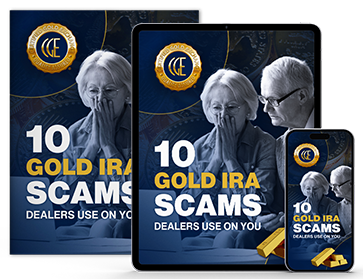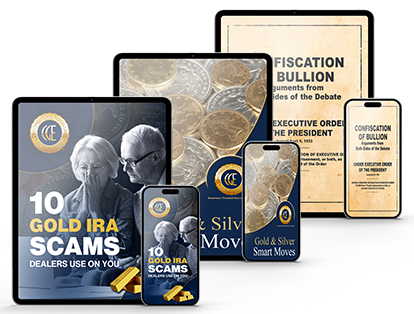Table of Contents
Gold 401K Rollover Investment Guide
An increasing number of investors are searching for a safe and effective way to protect their retirement savings in 2023. Many are concerned that the stock market is overvalued and will crash again like it did in 2008. And with inflation raging at 40-year highs, neither of these scenarios paint a rosy picture for 401(k) plans invested in traditional paper assets.
Just look at the blue line on the following chart. The 12-month percentage change in the CPI (Consumer Price Index) for all items is up from 2.6% to 8.5%. That’s an increase of over 300% in one year! This is obviously not sustainable. The dollar is being printed into oblivion. It’s no wonder investors are running for the exits and trying to protect their hard-earned retirement savings with physical gold.

History of 401(k) Plans
401(k) plans were legally permitted with the passing of the Revenue Act of 1978. The Act contained a provision to the Internal Revenue Code – Section 401(k) that enabled employers to establish tax-deferred savings accounts for their employees. Then in 1980, Ted Benna, a retirement benefits consultant, was hired by a bank to develop a more tax-friendly retirement option for its employees. He devised a plan for employees to contribute pre-tax money to a retirement account, with the incentive that their employer could match the employee contributions. A matched contribution incentive had never been done before, and because of that, Bennas’s client rejected the plan. But Ted Benna believed in the tax benefits of his idea. Using his unique interpretation of the law, he created the first-ever 401(k) plans for his employees at The Johnson Companies. Benna then lobbied the IRS to change some proposed rules of the law, and by 1981 they issued formal guidance for 401(k) plans. Within only two years, almost half of all large US corporations were offering a 401(k) plan or were planning to do so, surveys show.What is a Gold 401(k)?
Although the term “gold 401(k)” is searched for 100’s of times a month, it’s a misnomer. Traditional gold 401(k) plans do not exist. As you have undoubtedly experienced, 401(k) plans have very limited investment options.
The only type of 401(k) that can hold physical gold is called a “Solo 401(k)”. These plans are specifically designed retirement accounts for self-employed individuals only. If you have any employees, you are no longer eligible for a Solo 401(k).
So if you have a traditional 401(k) plan like most people, you must roll your retirement account over to a Self-Directed IRA to hold physical gold. You heard that right. There is no such thing as a gold 401(k).
Why Can’t I Buy Gold in my 401(k)?
Because Wall Street can’t make money on it. As seen in the chart below, as of March 31, 2021, 401(k) plans held a whopping $6.875 trillion in assets. That’s nearly one-fifth of the $34.9 trillion US retirement market. So why would Wall Street opt to give up a portion of their cash cow if they don’t have to? The answer is, they wouldn’t.
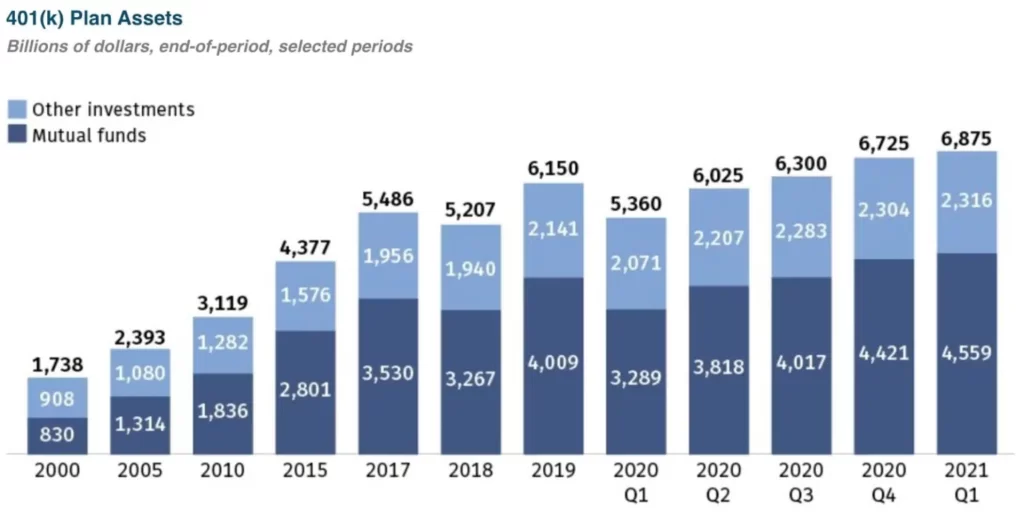
Because if they wanted to offer you gold coins, they could. Per the Internal Revenue Code Section 408(m), only life insurance and collectibles are prohibited in retirement accounts. 401(k) investment options, however, are typically limited to paper assets. Below are the asset classes and allocations of retirement funds in 401(k)s and an accompanying chart. Notice how they are all Wall Street products.
- Equity Funds (Mutual Funds, Index Funds)
- Target Date Funds
- Bond Funds
- GICs and Stable Value Funds
- Non-Target Date Balanced Funds
- Company Stock
- Money Market Funds
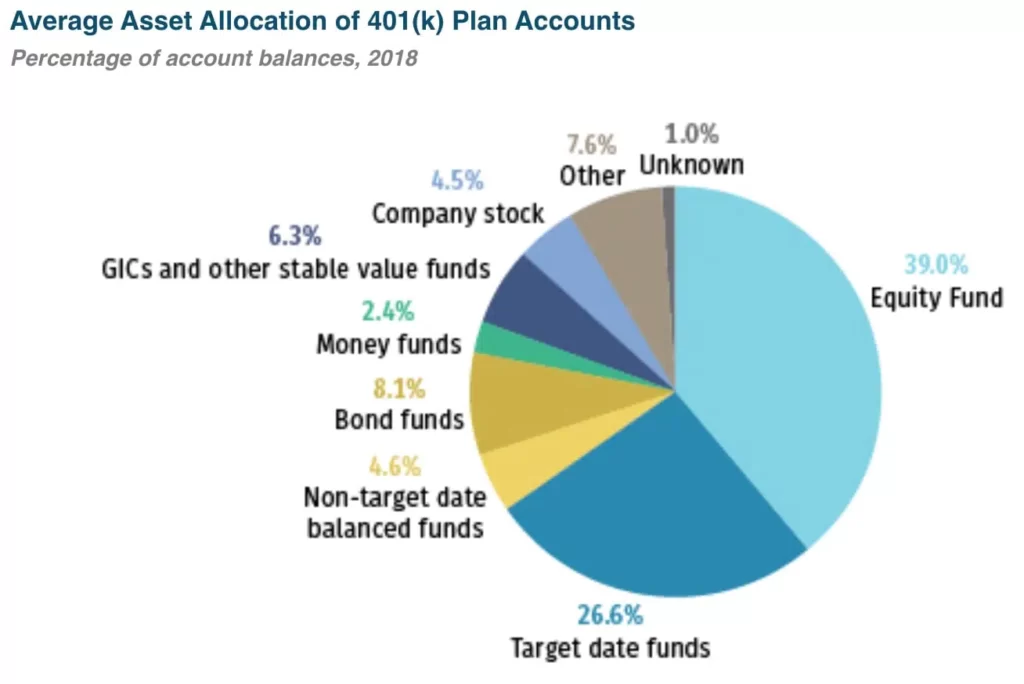
You see, there’s no money in allowing you to buy gold or other precious metals in your retirement savings account. There are no commissions to be made or fees to be generated from trading your account. This is why your 401(k) provider, typically a big Wall Street bank, doesn’t offer you precious metals as an investment option even though they are legally permitted to do so.
What Options Do I Have With My 401(k)?
Rollover
If you no longer work with the company that sponsored your 401(k), you are free to roll it over to a Self-Directed gold or silver IRA account.
In-Service Distribution
If you are still employed with the company that sponsored your plan but are over 59.5 years of age, you most likely qualify for an “in-service” distribution. Which means you can access the fully vested portion of your retirement account.
Call Your Provider
If you’re still employed with your plans sponsor and are not over 59.5, chances are you can’t touch your account. But be sure to contact your plan provider to confirm.
How Do I Rollover an Old (Inactive) 401(k) Into a Gold and Silver IRA?
To roll over an old 401(k) into a precious metals IRA, you must first establish a new account with an IRA custodian.
Once established, call your existing 401(k) provider and request that they initiate a rollover. You will then provide them with your new custodians’ information and your account number.
Your plan provider will mail a check of the rollover proceeds either directly to your new IRA custodian or to you to forward to them.
You now have 60 days from the issuance of the rollover check to deposit said funds into your new IRA account. Failure to do so within the allotted time frame will cause your “rollover” to be treated as a distribution, and you’ll have to pay income taxes on the total amount.
Can I Get Professional Help Completing My Gold IRA Rollover?
Yes! If you are rolling over an old 401(k) to a gold IRA or taking an in-service distribution after 59.5 years of age, the Certified Gold Exchange can help. Our precious metals experts can assist you with every step of the rollover process. Call our qualified precious metals IRA experts today at 800-300-0715 to discuss your options to solidify your retirement nest egg with Internal Revenue Service approved gold and silver bullion.
Once I Set Up My New Precious Metals IRA, How Do I Make a Purchase?
If you choose to use the Certified Gold Exchange as your precious metals dealer, the process will look like this:
Your designated gold IRA specialist will help you decide what type of physical precious metals will best support you in reaching your financial goals.
Our PriceMatchPlus team will perform a nationwide search amongst over 3,000 dealers to find the lowest price on your selected items.
Your gold IRA specialist will send you an email with links to websites with the three lowest prices, and they’ll beat that pricing.
You receive an email with an Investment Direction that details your gold and silver purchase. You’ll sign and date the document and return it to CGE for processing.
Because gold and silver are tangible, unlike other assets, it will typically take around 7-10 days for your precious metal to arrive and be inventoried at the 3rd party depository.
Note that if you choose another third-party dealer, you will end up paying more for your precious metals than necessary. Always call the Certified Gold Exchange at 800-300-0715 to compare pricing and make sure you’re getting the best deal possible on gold and silver.
What Kind of Precious Metals Can I Hold in a Self-Directed IRA?
Gold and silver coins are by far the most popular investment option. Although investors can also possess bullion bars, as well as select platinum and palladium items. It is important to note that these precious metals must meet specific purity requirements and maintain a Brilliant Uncirculated condition. The next section provides an in-depth explanation.
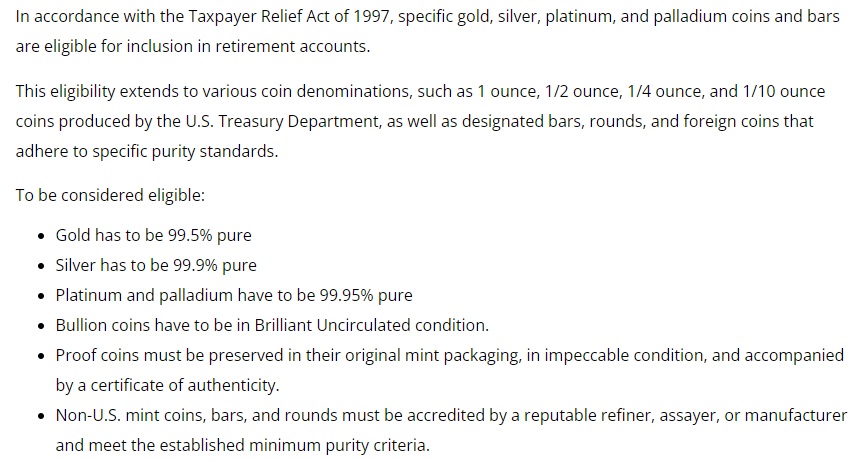
Can I Only Hold Numismatic Coins In My New Self-Directed Individual Retirement Account?
Per the Internal Revenue Code Section 408(m), collectible coins are not permitted in an individual retirement account. However, Proof Coins from the United States Mint, which do contain numismatic value, are the exception. Below is an example.

Am I Taxed If I Roll My 401(k) Into a Precious Metals IRA Holding Gold Coins?
Not if you deposit your rollover check into your new traditional ira within the allotted 60 days. For example, suppose you receive your rollover check and forget to send it to the IRA trustee. In that case, the transaction will be considered a distribution, and there will be tax consequences. The total rollover amount will be included in that year’s taxable income.
Can I Take Physical Possession of the Gold and Silver in My New IRA Account?
No. Some proponents of Checkbook IRAs state that you can hold your physical gold in a safety deposit box at your local bank. But your precious metals must be stored at an approved 3rd party depository per the IRS. If you attempt to store your precious metals personally and get caught, you’ll have to pay IRS penalties. Below is a screenshot directly from the IRS website that explains why.

If My 401(k) Is Still Active and I Am Under 59.5 Years of Age, Can I Still Get Exposure to Gold and Silver?
Very few 401(k) plans allow investing in precious metals directly, as only the rare exception will allow an account owner to purchase gold and silver bullion (or other commodities). Nevertheless, there are different ways to gain exposure to gold investments or other precious metals within a 401(k)’s investment portfolio:
Gold Mutual Funds
401(k) plans can offer various mutual fund investment options, and some may focus on gold. These funds can provide exposure to gold itself or gold-related activities. For example, the Fidelity Select Gold Fund (FSAGX) is an actively managed gold-focused mutual fund with holdings in gold production, mining and exploration companies.
Physical Gold ETF
401(k) plans with a brokerage account feature make it possible to invest in gold Exchange Traded Funds. These ETFs are an easy way to gain direct exposure to gold prices, as the funds usually hold gold bullion bars. (Some might buy physical silver too.)
The Aberdeen Standard Physical Gold Shares ETF (SGOL), Invesco DB Precious Metals Fund (DBP), and SPDR Gold MiniShares Trust (GLDM) are three popular gold ETFs.
Gold Mining Stocks
If your 401(k) is linked to a brokerage account that allows active trading, you can purchase individual gold stocks. But mining stocks can be very volatile, so make sure to ask your financial advisors for input.
Start a New Gold IRA
Although not the best option, because you have to comply with contribution limits, many investors will start a brand new traditional or Roth IRA. The maximum IRA contribution limits are $6,000 per year or $7,000 if you are over 50 years of age. If you have an existing IRA, you cannot exceed the above limits between both accounts.
Traditional IRAs are funded with pre-tax dollars. While a Roth IRA will be funded with post-tax dollars. The contribution limits are the same.
Once your conventional IRA is established and funded, you can buy gold or silver or other precious metals like platinum and palladium bullion. Depending on the type of IRA account you set up, you can also purchase gold mining stocks, gold ETFs or gold mutual funds.
Why Are So Many Investors Rolling Over 401(k) Accounts into Gold IRAs Right Now?
Individual investors increasingly want to rollover their 401(k) plans to gold IRAs because:
- They want to protect their wealth from rapidly rising inflation.
- They want to avoid another stock market crash that devastated retirement accounts.
- They are concerned with the skyrocketing national debt.
- Gold and silver IRAs historically protect from paper currency devaluations.
- Physical precious metals IRAs are debt-free assets and are less complex than traditional stocks.
- They can’t afford to lose money or another 50% of their retirement account again at this stage of life.
- Buying gold in times of great uncertainty is prudent and time-tested.
- They simply want the peace of mind only a physical gold IRA can provide.
Written by Gold IRA Specialists Pat Collins and John Halloran


Avoid These 10 Gold IRA Scams.

DEALERS USE ON YOU




